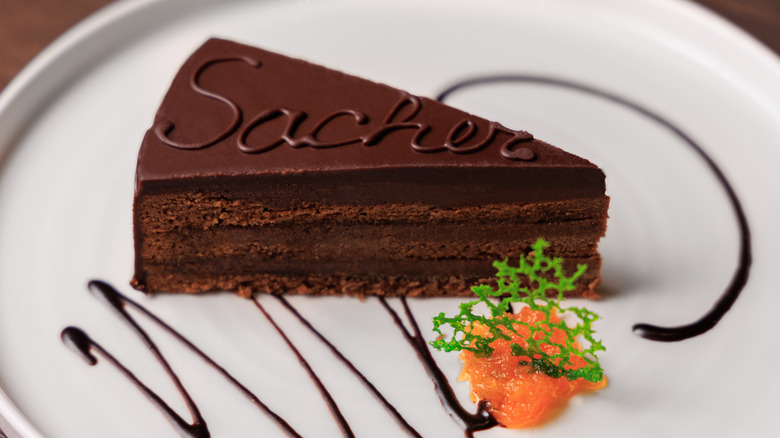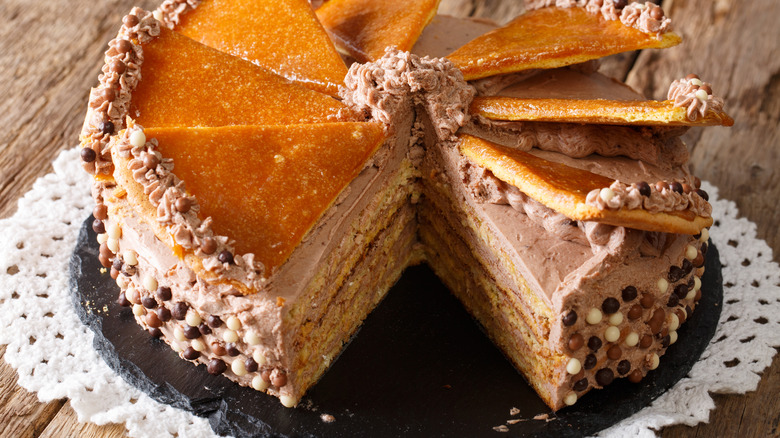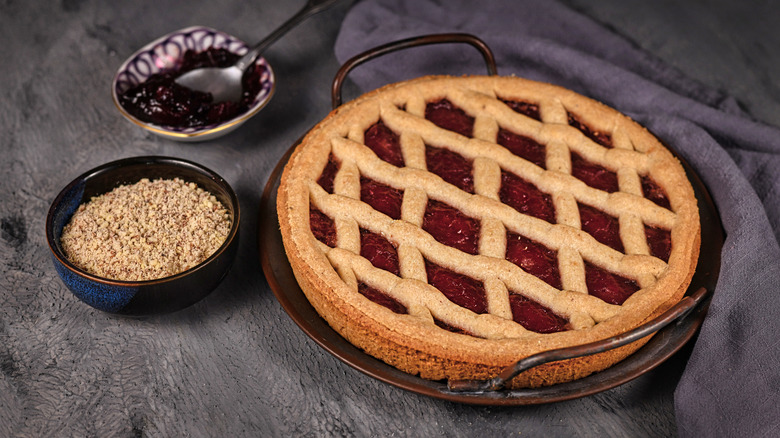Is There Any Real Difference Between A Torte And Cake?
Answering the question posed in the title — whether there is a difference between cakes and tortes — sets up an exercise in conditional logic similar to asking if there is a difference between fruits and pineapples or between bread and brioche. What we're getting at here is that, according to the dictionary definition (Merriam Webster's and the International Food Dictionary's to name but a few), a torte is a type of cake, although not all cakes are tortes. There, are we done now? You know we're not, since there's quite a bit more to be said on the subject.
Cakes in general are, as per those same sources, typically sweet baked goods often made from flour, sugar, eggs, fat, and a raising agent such as baking powder. Of course, exceptions exist because savory cakes are a thing, as are vegan ones. The word can also apply to other types of foods such as pancakes or fish cakes as well as non-food items like cakes of soap. A torte, however, is usually a sweet dessert-style cake, one that might be made with ground nuts or crumbs and may also be multi-layered with a creamy, custardy, or fruity filling.
Linguistics tend to blur the lines, though
While dictionaries do their best to establish what a torte is, it's difficult to pin things down. If you look up torte recipes, you'll find quite a few that are made with, well, cake, and no crumbs are involved in the mix. One of the best-known ones is the Hungarian dobos torte, which consists of multiple thin layers of cake (baked separately, not sliced, at least if you're doing it right) sandwiched together with a flavorful filling. The Americanized version of this cake is New Orleans' doberge cake (doberge being a Franglicisation of the Hungarian name dobos), but the latter is called a cake while the former is always referred to as torte. Maryland's Smith Island cake, a similar multi-layered concoction, is likewise called cake and never torte. What gives?
If you go through a list of cakes commonly known as tortes, which includes the aforementioned dobos torte as well as the equally Hungarian Esterhazy torte, the Austrian Sacher torte and mandel torte, and the Italian torta Caprese (which may be called a flourless chocolate torte in English translations), you'll notice one thing they all have in common: European origins. In both Italy and Hungary, the word "torta" simply means "cake," while "torte" is a German word with the same meaning. What it boils (or bakes) down to is that if a recipe comes from a country where cake is called torte or torta, it may continue to be known by that name.
One well-known torte isn't all that cake-like
While most tortes are, indeed, cakes (with the possible exception of the individual pistachio "tortes" in our recipe, which are really just parfaits), one of the most famous tortes of all is actually not remotely cake-like. The Linzer torte, a 17th-century recipe for which have led some to call it the oldest dessert in the world, is more like a pie or perhaps an oversized cookie of sorts. Definitely not remotely cake-like by most definitions, although it does, in fact, contain those ground nuts that are notably lacking in the tortes we mentioned above.
A traditional Linzer torte is made with a base of what is essentially sweetened pie dough or perhaps shortbread cookie dough into which ground nuts have been mixed. The crust is then topped with jam and the torte is finished off with a lattice made from strips of the same dough used for the crust -– again, something you'd see on a pie, not a cake. So why is a Linzer torte called a torte if it isn't really a cake at all? Well, this dish, like the Sacher and mandel tortes, also hails from Austria, a country whose official language is German. The German word for tart is, yep, "torte," so ... Don't overthink it. A torte by any other name would still be delicious, so perhaps that's all we really need to know.


